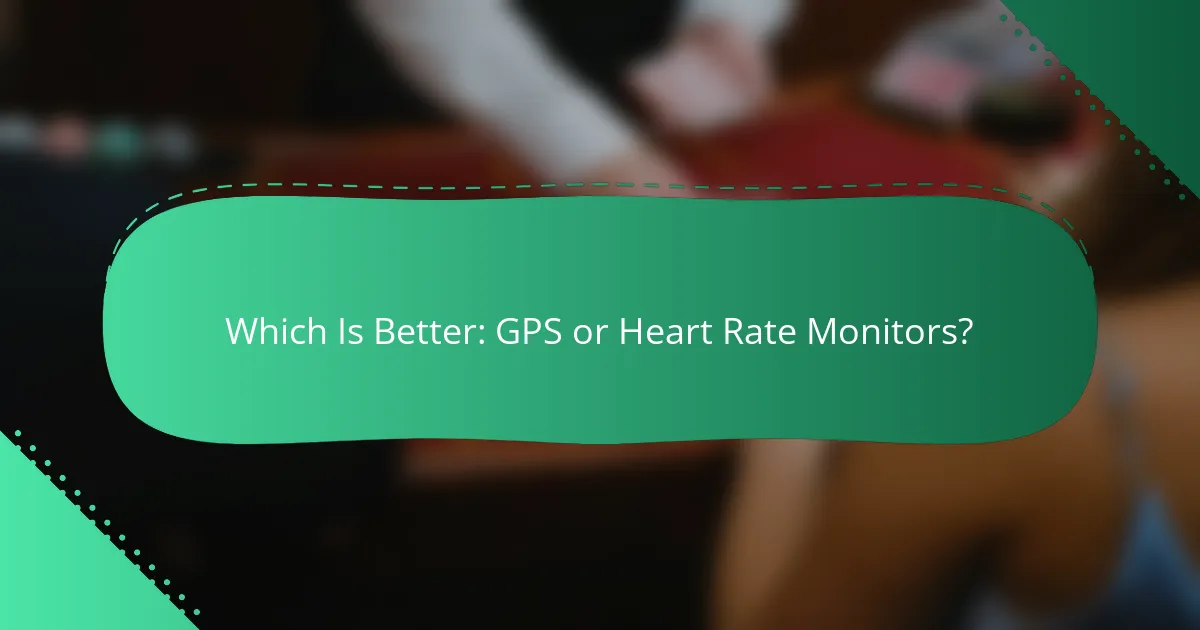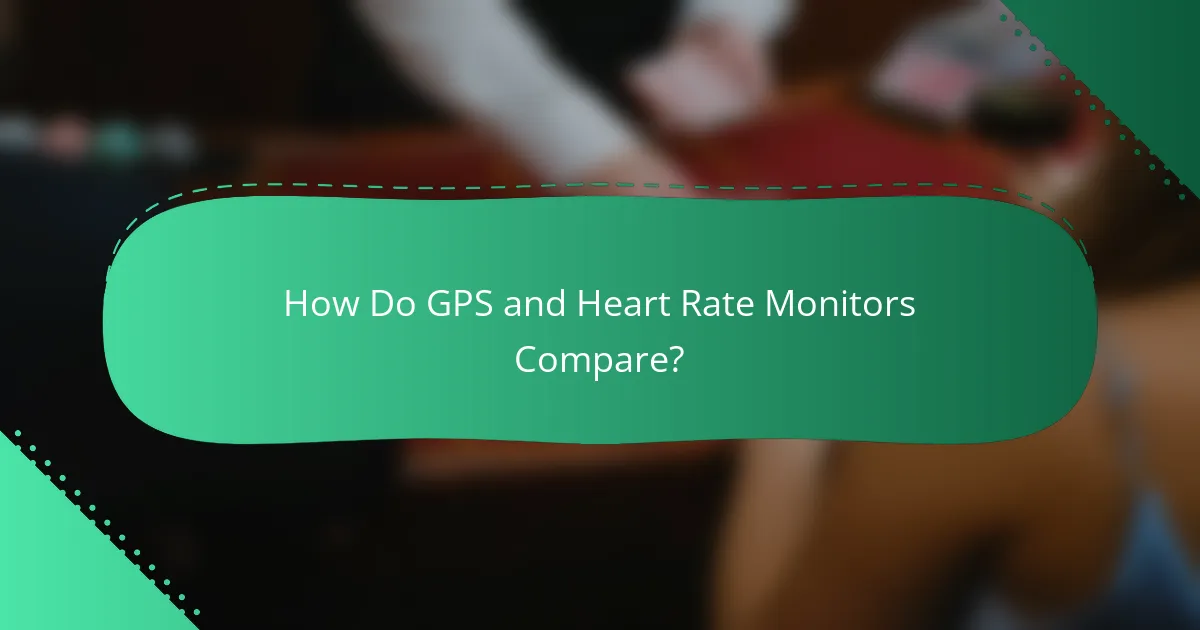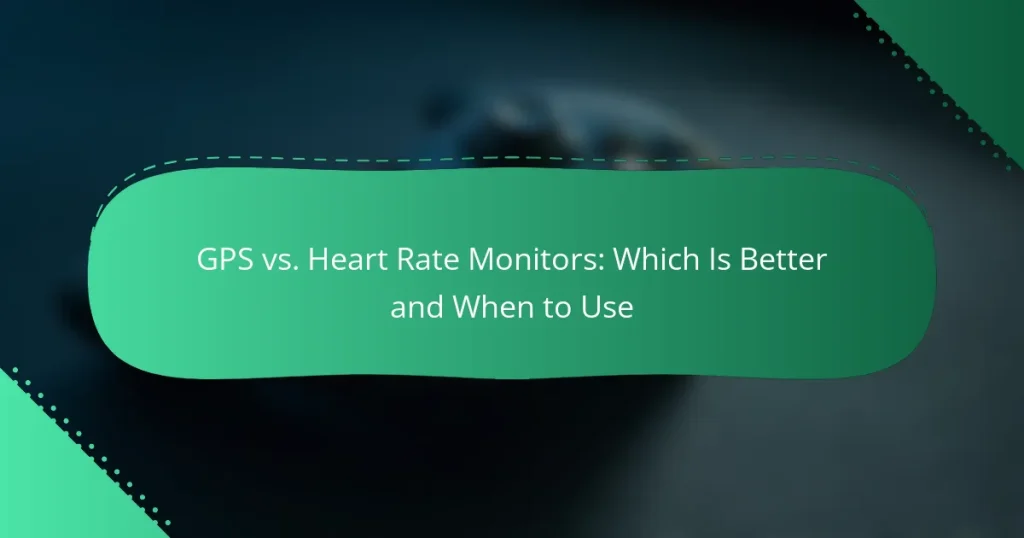When deciding between GPS and heart rate monitors, it’s important to consider your specific fitness goals and activities. GPS devices are perfect for outdoor enthusiasts who need to track distance and navigate routes, while heart rate monitors are crucial for those looking to optimize their workout intensity and monitor cardiovascular performance.

Which Is Better: GPS or Heart Rate Monitors?
Choosing between GPS and heart rate monitors depends on your specific needs. GPS devices excel in outdoor navigation and route tracking, while heart rate monitors are essential for assessing fitness levels and workout intensity.
GPS for outdoor navigation
GPS devices are designed to provide accurate location tracking and navigation, making them ideal for outdoor activities like hiking, running, or cycling. They use satellite signals to determine your position, allowing you to map routes and explore new areas.
When selecting a GPS device, consider factors such as battery life, screen visibility in sunlight, and additional features like topographic maps or waypoint marking. A good GPS can help you stay oriented and avoid getting lost during your adventures.
Heart rate monitors for fitness tracking
Heart rate monitors focus on tracking your heart rate during physical activities, providing insights into your fitness level and workout intensity. These devices can be worn as chest straps or wristbands, and they often sync with fitness apps for detailed analysis.
Using a heart rate monitor can help you optimize your training by ensuring you stay within your target heart rate zones. This is crucial for improving endurance and achieving fitness goals. Look for features like real-time heart rate feedback and recovery tracking when choosing a monitor.
Use cases for both devices
GPS devices are best suited for outdoor enthusiasts who need navigation assistance and route tracking. They are particularly useful for long-distance runners, cyclists, and hikers who venture into unfamiliar territories.
Heart rate monitors are ideal for individuals focused on improving their fitness levels or training for specific events. They help in monitoring heart rate variability, which can indicate overall health and recovery status. Many athletes use both devices to gain a comprehensive understanding of their performance and health metrics.

When Should You Use GPS Devices?
GPS devices are ideal for tracking distance, speed, and route during outdoor activities. They are particularly useful when navigating unfamiliar areas or when precise location data is essential for safety or performance.
Long-distance running
For long-distance running, GPS devices provide real-time data on pace and distance, helping runners maintain their target speeds. Many runners find that using GPS watches can enhance their training by allowing them to analyze their performance over time.
When selecting a GPS device for running, consider battery life, as longer runs may require devices that can last several hours. Look for features like interval training and route mapping to tailor your workouts effectively.
Hiking and outdoor activities
In hiking and other outdoor activities, GPS devices are invaluable for navigation and safety. They can help track your route, monitor elevation changes, and provide location data in remote areas where cell service is unavailable.
Choose a GPS device that is rugged and water-resistant, as outdoor conditions can be harsh. Additionally, consider models with topographic maps and waypoint marking features to enhance your hiking experience and ensure you stay on track.

When Should You Use Heart Rate Monitors?
Heart rate monitors are essential for tracking your cardiovascular performance during various types of workouts. They provide real-time data on your heart rate, helping you optimize your training intensity and improve fitness outcomes.
Cardio workouts
During cardio workouts, heart rate monitors help you maintain the right intensity level to maximize fat burning and cardiovascular benefits. Aim to keep your heart rate within 50-85% of your maximum heart rate, depending on your fitness goals. For example, if your maximum heart rate is around 180 beats per minute, target a range of 90-153 bpm.
Using a heart rate monitor can also prevent overtraining by alerting you when your heart rate exceeds safe limits. This is particularly useful for beginners or those returning to exercise after a break.
Interval training
In interval training, heart rate monitors are crucial for tracking your performance during high-intensity bursts followed by recovery periods. They allow you to gauge how quickly your heart rate recovers, which is a key indicator of cardiovascular fitness. Aim for a heart rate that spikes to 80-90% of your maximum during intense intervals, then let it drop back down during rest periods.
To effectively use a heart rate monitor in interval training, consider setting specific heart rate targets for each interval. This ensures you push yourself adequately during high-intensity phases while allowing sufficient recovery time, enhancing overall workout efficiency.

How Do GPS and Heart Rate Monitors Compare?
GPS and heart rate monitors serve different purposes in fitness tracking, making them suitable for various activities. GPS primarily tracks location and distance, while heart rate monitors focus on measuring heart rate and exertion levels.
Accuracy in tracking
GPS devices excel in tracking distance, speed, and route, providing accurate data for outdoor activities like running and cycling. However, their accuracy can be affected by environmental factors such as tall buildings or dense foliage, which may lead to discrepancies in distance measurements.
Heart rate monitors, on the other hand, offer precise heart rate readings, which are crucial for understanding workout intensity. They can be particularly effective during high-intensity workouts or interval training, where monitoring heart rate variability is essential for performance optimization.
Battery life differences
Battery life varies significantly between GPS devices and heart rate monitors. GPS units typically have a shorter battery life, often lasting around 10 to 20 hours depending on usage and settings, especially when using features like continuous tracking.
Heart rate monitors generally have longer battery life, often lasting several days to weeks on a single charge, particularly if they are used for basic heart rate tracking without additional features. This makes them more convenient for daily wear and longer training sessions.
Cost comparison
The cost of GPS devices usually ranges from moderate to high, often starting around $100 and going up to several hundred dollars for advanced models with additional features. These devices are an investment for serious athletes who require detailed tracking.
Heart rate monitors tend to be more affordable, with basic models available for as low as $30 to $50. However, advanced models with integrated GPS and additional metrics can also reach higher price points. When choosing between the two, consider your specific needs and budget to find the best fit for your training regimen.

What Are the Key Features to Consider?
When choosing between GPS and heart rate monitors, it’s essential to consider their primary functions and how they align with your fitness goals. GPS devices excel in tracking distance and speed, while heart rate monitors focus on cardiovascular performance and intensity levels.
GPS accuracy
GPS accuracy is crucial for measuring distance and speed during outdoor activities. Most modern GPS devices can provide accuracy within a few meters, but factors like tree cover, urban environments, and satellite positioning can affect performance. For best results, use GPS devices in open areas and allow them to establish a strong signal before starting your activity.
Consider that GPS accuracy can vary by device and conditions. High-quality units typically offer better precision, while budget options may have limitations. If precise tracking is vital, look for devices that include features like GLONASS or Galileo support for enhanced satellite coverage.
Heart rate variability tracking
Heart rate variability (HRV) tracking measures the fluctuations in time between heartbeats, providing insights into your autonomic nervous system and overall recovery. This feature is significant for athletes looking to optimize training loads and monitor stress levels. Devices that offer HRV tracking can help you determine when to push harder or when to rest.
When selecting a heart rate monitor, ensure it provides reliable HRV data. Look for devices that use optical sensors or chest straps, as they tend to deliver more accurate readings. Regularly monitoring HRV can help you make informed decisions about your training and recovery strategies.

What Are the Best GPS Devices Available?
The best GPS devices combine accuracy, ease of use, and features tailored to specific activities like running, cycling, or hiking. Popular options include the Garmin Forerunner series and the Suunto 9, both known for their reliability and advanced functionalities.
Garmin Forerunner series
The Garmin Forerunner series is highly regarded among athletes for its precision and extensive features. These devices offer built-in GPS, heart rate monitoring, and various sports modes, making them suitable for runners, cyclists, and triathletes.
When choosing a model, consider factors like battery life, which can range from several hours to over a week depending on usage and settings. The Forerunner 245, for example, is ideal for casual runners, while the Forerunner 945 caters to serious competitors with advanced metrics and longer battery life.
Suunto 9
The Suunto 9 is designed for outdoor enthusiasts who require a robust GPS device. It features a durable build, long battery life, and intelligent battery management, allowing users to select different modes based on their activity duration.
This device is particularly useful for hikers and adventurers, as it supports various navigation features and can withstand harsh weather conditions. It’s essential to consider its size and weight, as it may be bulkier compared to other options, which could affect comfort during extended wear.

What Are the Best Heart Rate Monitors Available?
The best heart rate monitors combine accuracy, comfort, and ease of use. Popular options include the Polar H10 and Wahoo Tickr, both known for their reliability and features tailored to various fitness levels.
Polar H10
The Polar H10 is a top-rated heart rate monitor that utilizes advanced technology to provide precise heart rate readings. It features a comfortable chest strap that ensures stability during workouts, making it suitable for both casual and serious athletes.
One of its standout features is Bluetooth connectivity, allowing it to sync with various fitness apps and devices. Users appreciate its long battery life, which can last up to several months, and its compatibility with gym equipment, enhancing its versatility.
Wahoo Tickr
The Wahoo Tickr is another excellent choice for heart rate monitoring, designed for both indoor and outdoor activities. It is lightweight and features a soft strap that minimizes discomfort during extended use.
This monitor also offers dual-band technology, enabling simultaneous connectivity to smartphones and GPS devices. With a battery life of up to a year, the Wahoo Tickr is a practical option for those who want a reliable device without frequent replacements.


